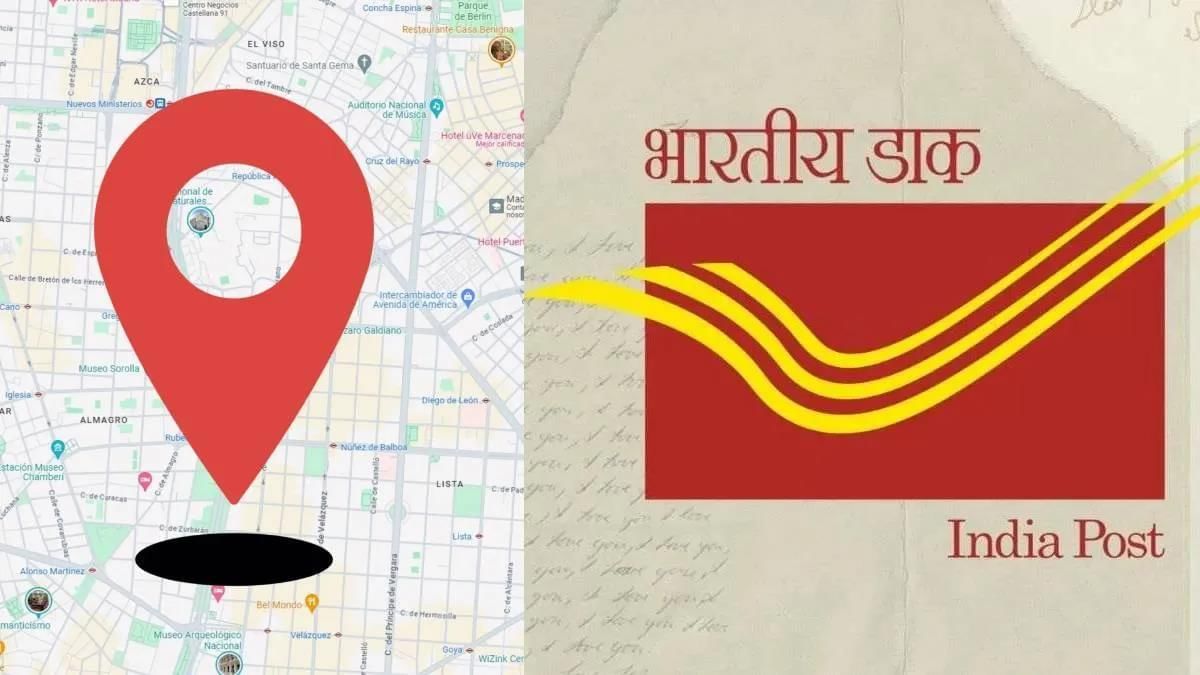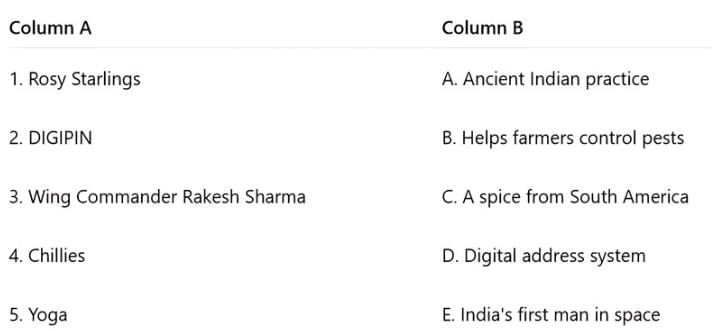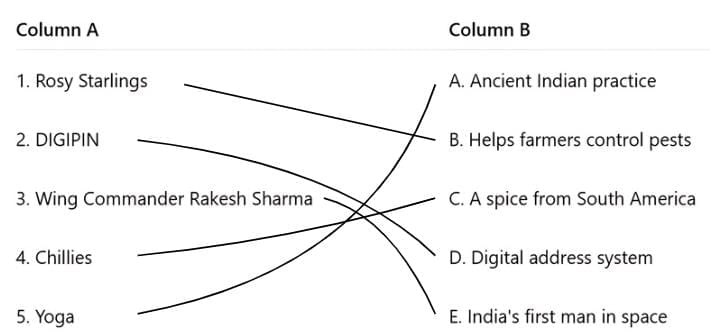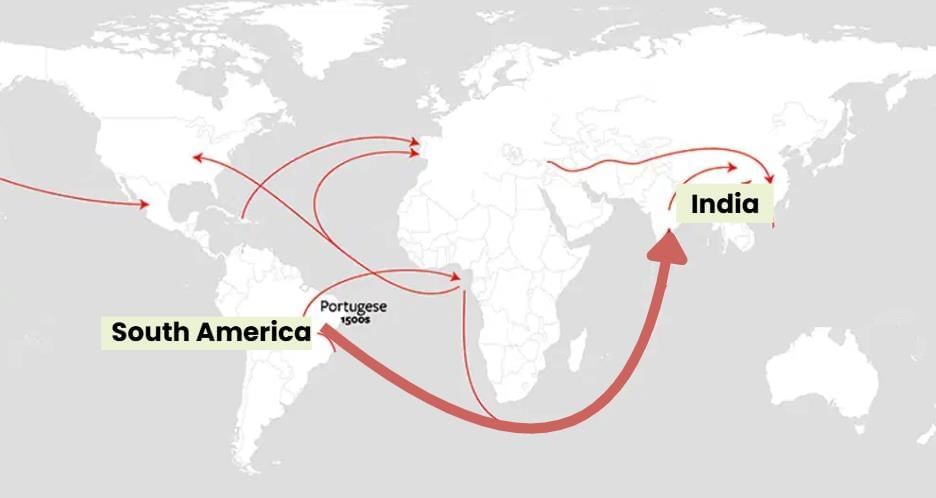Worksheet Solutions: Earth — Our Shared Home | EVS Class 5 PDF Download
Q1: Choose the correct option for each question.
(i) Who was the first Indian in space?
A. Wing Commander Rakesh Sharma
B. Group Captain Shubhanshu Shukla
C. DIGIPIN
D. None of the above
Ans: A. Wing Commander Rakesh Sharma
(ii) What does DIGIPIN help with?
A. Assigning names to schools
B. Helping postmen locate addresses
C. Identifying plants
D. None of the above
Ans: B. Helping postmen locate addresses DIGItal PIN helps postmen to find address
DIGItal PIN helps postmen to find address
(iii) What ancient Indian practice is celebrated on International Day of Yoga?
A. Meditation
B. Dance
C. Yoga
D. Painting
Ans: C. Yoga
(iv) From where did chillies originally come?
A. India
B. Europe
C. South America
D. Africa
Ans: C. South America
(v) What unique feature do Indian cows in Brazil have?
A. They are used for transportation
B. They are depicted on stamps and coins
C. They are larger than Brazilian cows
D. None of the above
Ans: B. They are depicted on stamps and coins
Q2: Match the items in Column A with the correct descriptions in Column B.

Ans:
Q3: Fill in the blanks with the correct words from the chapter.
(i) The Earth looks like one big home with no visible __________.
(ii) Yoga has been practised in India for more than __________ years.
(iii) The Ministry of __________, Forest and Climate Change logo shows the connection between humans and nature.
(iv) Chillies were brought to India by __________ travellers.
(v) The saying 'Vasudhaiva Kutumbakam' means __________ is one family.
Ans:
(i) The Earth looks like one big home with no visible borders.
(ii) Yoga has been practised in India for more than 5,000 years.
(iii) The Ministry of Environment, Forest and Climate Change logo shows the connection between humans and nature.
(iv) Chillies were brought to India by Portuguese travellers.
(v) The saying 'Vasudhaiva Kutumbakam' means the world is one family.
Q4: State whether the following statements are True or False. Correct the false statements.
(i) The shape of land and sea is visible from space, but no political boundaries.
Ans: True
(ii) The marigold flower originally comes from India.
Ans: False
(iii) The first Indian in space said India looked "Saare Jahaan Se Achcha" from space.
Ans: True
(iv) Yoga was first shared with the world in the 21st century.
Ans: False Yoga
Yoga
(v) The chillies we grow in India were once a staple item in European kitchens.
Ans: False
Q5: Answer the following questions in 2-3 sentences each.
(i) What does the Earth look like from space?
Ans: From space, the Earth looks like one big home. You can't see any borders or countries, just land and sea. Everything looks tiny, and we can see how nature connects us all.
(ii) How do rosy starlings help farmers in India?
Ans: Rosy starlings are pink and black birds that come to India every winter. They eat locusts and grasshoppers, which helps farmers by controlling pests that can harm crops.
(iii) Why is yoga special and important?
Ans: Yoga is an ancient practice from India that helps people stay strong and happy. It has been practised for over 3,000 years and is now enjoyed by people all around the world.
(iv) Where did chillies originally come from?
Ans: Chillies originally came from South America. They were brought to India by Portuguese travellers 400 to 500 years ago and became a popular spice in Indian cooking.
(v) What does "Vasudhaiva Kutumbakam" mean?
Ans: "Vasudhaiva Kutumbakam" is a phrase from India that translates to "the world is one family." It teaches us to live with love, care, and respect for each other and our planet.
Q6: Answer the following questions in 4-6 sentences each. Use examples from the chapter to support your answers.
(i) Explain how birds like rosy starlings show us that "nature has no boundaries."
Ans: Rosy starlings are small birds that travel thousands of kilometres every winter from Russia and Mongolia to India. This shows nature has no boundaries because:
- Rosy starlings fly from Russia and Mongolia to India every winter
- They travel thousands of kilometres without passports or borders
- These birds help Indian farmers by eating harmful insects like locusts
- This shows all living things on Earth are connected and help each other
(ii) How did the chilli plant change Indian food culture? Trace its journey from South America to India.
Ans: The chilli completely transformed Indian cooking and shows how food travels across the world:
- Chillies originally grew only in South America
- Portuguese traders brought them to India 400-500 years ago
- Before chillies, Indians used black pepper for spicy food
- Now chillies are essential in Indian cooking
- This shows how plants can travel and become part of new cultures
 Portuguese brought Chilli from South America to India (1500s)
Portuguese brought Chilli from South America to India (1500s)
(iii) What does "Vasudhaiva Kutumbakam" mean? How can we live as one family despite our differences?
Ans: "Vasudhaiva Kutumbakam" is an ancient Indian saying that translates to "the world is one family."
- It teaches us that all people, animals, trees, rivers, and nature belong to one big family
- We all share the same Earth as our home and depend on each other
- We can live as one family by:
Respecting differences
Sharing resources and helping others
Caring for the environment
(iv) Give examples of how India and other countries have shared culture, food, and ideas with each other.
Ans: India and other countries have shared many things, creating global connections:
From India to the world:
- Yoga - practised worldwide for health and peace (International Yoga Day on June 21)
- Sugar-making technique - spread from India to other countries
- Indian cow breeds (Gir, Kankrej, Ongole) - now produce milk in Brazil
From other countries to India:
- Chillies from South America - now essential in Indian food
- Marigold flowers from Mexico - used in Indian festivals and temples
- Paper from China - replaced palm leaves for writing
This shows how cultures mix and enrich each other, making our world more connected and diverse.
|
53 videos|388 docs|51 tests
|
FAQs on Worksheet Solutions: Earth — Our Shared Home - EVS Class 5
| 1. What are the main components of Earth that make it a unique planet? |  |
| 2. How does Earth's atmosphere support life? |  |
| 3. What are the consequences of pollution on Earth? |  |
| 4. Why is it important to conserve natural resources? |  |
| 5. How can individuals contribute to protecting the Earth? |  |




















